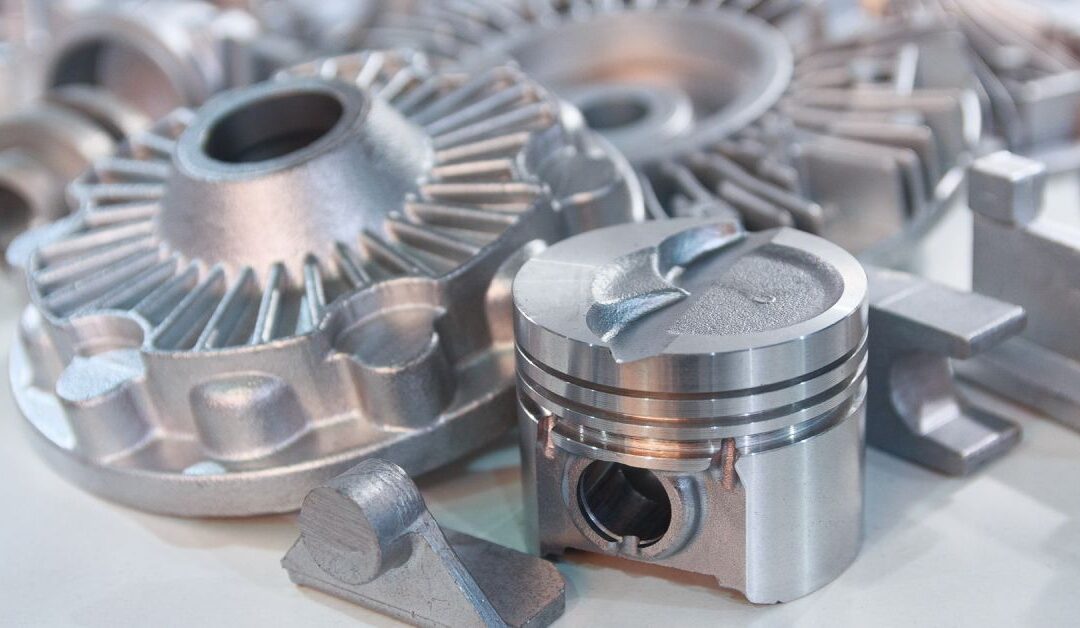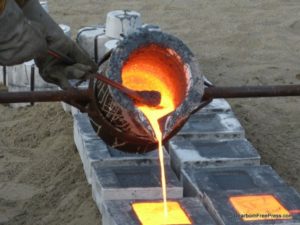Comprehending the Steel Castings Refine: A Comprehensive Guide for Beginners
The Metal Casting procedure is a fundamental method in making that changes molten steel into strong forms. Newbies should comprehend the various methods entailed, such as sand spreading and die spreading. Comprehending the products, style principles, and safety procedures is similarly essential. Each element plays an essential role in attaining effective results. As one navigates these details, the inquiry of exactly how to optimize each step for boosted results becomes significantly essential.
The Basics of Metal Casting
Although Metal Casting has actually developed over centuries, its essential principles continue to be consistent and indispensable to the production procedure. At its core, Metal Casting involves the improvement of liquified metal into solid items through various techniques. The process begins with the production of a mold and mildew, which defines the form of the last item. As soon as the mold is prepared, steel is heated to its melting point and poured right into the tooth cavity. After cooling, the steel strengthens, taking the shape of the mold.
There are numerous casting methods, consisting of sand spreading, investment spreading, and die casting, each with unique benefits and applications. The option of strategy depends on aspects such as production quantity, product type, and desired precision. As soon as cast, the final product might undertake extra processes like machining or surface area therapy to attain the needed coating and specs. Recognizing these fundamentals is essential for any individual curious about the area of Metal Casting.

Recognizing Products Used in Metal Casting
Products play a vital duty in the Metal Casting process, influencing the last product's residential or commercial properties and efficiency. Numerous metals are made use of, consisting of light weight aluminum, iron, steel, and bronze, each offering unique characteristics fit for particular applications. Aluminum is corrosion-resistant and lightweight, making it ideal for automotive parts. Iron, specifically cast iron, is preferred for its exceptional wear resistance and sturdiness. Steel gives high toughness and versatility, typically used in heavy equipment components. Bronze, recognized for its deterioration resistance and machinability, is generally utilized in marine applications.
In addition to the steels, numerous casting materials, such as sand, plaster, and ceramic, are made use of to develop molds. Sand spreading, the most common approach, utilizes silica sand because of its thermal stability and capability to create detailed forms. Plaster and ceramic molds use finer details however may require more complicated processes. The selection of materials directly influences the performance, price, and top quality of the casting operation.
The Design Refine: From Idea to Blueprint
The style process in Metal Casting starts with the first principle advancement, where ideas are produced and evaluated. This is adhered to by the application of CAD modeling methods, enabling precise visualizations of the layout. Finally, the blueprint completion steps assure that all requirements are properly recorded for production.
Preliminary Concept Growth
First principle development notes an important phase in the Metal Casting process, where concepts transform right into tangible styles. During this stage, designers team up with stakeholders and engineers to brainstorm and refine first ideas. They take into consideration factors such as capability, aesthetic appeals, and manufacturability, guaranteeing that the layout satisfies the called for specs and efficiency requirements. Sketches and outlines are produced to picture the concepts, permitting initial evaluations of usefulness and cost-effectiveness. This phase also involves determining materials and potential spreading methods that align with the layout goals. Ultimately, preliminary idea growth lays the groundwork for a complete blueprint, assisting the subsequent phases of the casting process and guaranteeing an effective shift from idea to reality.
CAD Modeling Techniques
Changing ideas right into specific styles, CAD modeling strategies play a pivotal function in the Metal Casting process. These strategies use sophisticated software program to create comprehensive three-dimensional versions that precisely show the desired item. By using devices such as parametric modeling, strong modeling, and surface area modeling, designers can adjust dimensions and forms effortlessly. CAD systems additionally promote simulation and evaluation, allowing for the recognition of possible problems prior to manufacturing starts. This aggressive technique decreases product waste and maximizes the style for manufacturability. In addition, CAD designs can be easily changed, making it possible for fast iterations based upon responses. Basically, CAD modeling works as the foundation of the style procedure, linking the gap in between initial concepts and the eventual production-ready designs.
Plan Completion Tips
Adhering to the creation of detailed CAD designs, the next phase involves blueprint completion, which is critical in equating electronic styles into actionable prepare for manufacturing. This procedure starts with evaluating the CAD designs for precision and conformity with specs. Once validated, the measurements, resistances, and product requirements are carefully outlined to assure clarity. Incorporating notes and notes assists interact necessary details regarding spreading processes, surface finishes, and assembly demands. The finalized blueprint goes through a rigorous approval process, frequently including cooperation with engineers and production teams to resolve any prospective problems. After all modifications are made and approvals obtained, the blueprint is formally launched, acting as the fundamental record for the subsequent stages of Metal Casting, consisting of pattern production and mold style.
The Steel Casting Strategies Clarified

Metal Casting techniques include a range of methods utilized to form molten metal right into preferred forms. These strategies vary according to the sort of material, intricacy of the design, and manufacturing volume. Sand casting is among the most typical methods, entailing the development of a mold from sand to hold the molten metal. Financial investment spreading, or lost-wax casting, enables detailed styles by utilizing a wax pattern that is dissolved. Die casting employs high-pressure shot of liquified metal right into a mold, ideal for automation. Various other approaches include long-term mold casting, which uses multiple-use mold and mildews, and centrifugal spreading, where rotational forces help in filling the mold. Each strategy has its advantages and applications, making it vital for makers to select the ideal technique based upon their certain demands and demands. Understanding these strategies is crucial for anybody included in the Metal Casting procedure.
Completing Procedures: Enhancing Your Casted Product

Finishing procedures play a necessary function in enhancing the quality and look of casted products. Numerous surface therapy techniques, such as polishing and finishing, are used to boost toughness and aesthetics. Additionally, quality inspection approaches assure that the last item meets defined requirements and efficiency needs.
Surface Area Therapy Strategies
A range of surface area treatment strategies play an important function in enhancing the top quality and long life of casted products. These techniques include techniques such as shot blasting, polishing, and finish. Shot blowing up properly gets rid of surface blemishes, boosting the practical and visual characteristics of the casting. Polishing supplies a smooth finish, which my response is specifically crucial for ornamental applications and components needing very little rubbing. Layer methods, such as electroplating or powder finish, offer extra defense against deterioration and wear, making certain longevity. Surface area therapies can enhance adhesion for succeeding procedures, such as paint or bonding. By utilizing these techniques, makers can achieve exceptional surface area high quality, which is crucial for the efficiency and lifespan of Metal Casting in numerous applications.
Quality Inspection Approaches
Effective high quality assessment techniques are crucial for ensuring the honesty and efficiency of casted items after the ending up procedures. Numerous techniques are used to evaluate the top quality of Metal Casting, consisting of visual examination, dimensional checks, and non-destructive screening (NDT) Aesthetic assessment enables the recognition of surface flaws, while dimensional checks ensure that products fulfill specified resistances. NDT approaches, such as ultrasonic testing and radiographic inspection, supply deeper understandings into inner honesty without harming the castings. Additionally, mechanical screening, such as tensile and hardness tests, assesses material properties - Aluminum Castings. By employing a combination of these techniques, producers can improve product high quality and dependability, ultimately bring about higher consumer contentment and lowered manufacturing expenses
Safety Considerations in Metal Casting
While the Metal Casting procedure provides many benefits, it likewise offers a series of safety risks that must be thoroughly taken care of. Employees in casting facilities are exposed to heats, liquified steels, and unsafe products, which can result in severe injuries if proper preventative measures are not taken. Personal safety tools (PPE) such as heat-resistant gloves, encounter shields, and safety clothes is important to reduce threats.
Furthermore, the visibility of fumes and dirt demands correct air flow systems to guarantee air quality - Metal Castings. Regular training web on security procedures is essential for all workers to acknowledge prospective dangers and react properly. Emergency situation procedures need to be developed, consisting of fire precaution and emergency treatment accessibility. Upkeep of equipment and appropriate handling of products further add to a more secure working environment. By prioritizing these security factors to consider, Metal Casting operations can safeguard their workforce and preserve reliable production procedures
Frequently Asked Questions
What Are the Environmental Impacts of Metal Casting?
Metal Casting can result in environmental influences such as air and water air pollution, source depletion, and energy usage. In addition, incorrect waste monitoring and discharges from foundries contribute to environmental disruptions and health and wellness threats for nearby areas.
Exactly how Do I Select the Right Steel for Casting?
To select the right metal for casting, one must think about elements such as mechanical homes, deterioration resistance, thermal conductivity, and cost. Examining the desired application and ecological problems is crucial for perfect option.
What Are the Typical Defects in Metal Casting?
Usual issues in Metal Casting consist of porosity, shrinkage, sand inclusion, and misruns. These issues frequently occur from improper product choice, insufficient style, or problems in the casting procedure, impacting the last item's high quality and efficiency.
Exactly How Can I Boost My Metal Casting Abilities?
To enhance Metal Casting abilities, one ought to practice consistently, research casting strategies, assess previous jobs for defects, look for responses from seasoned casters, and constantly trying out different products and methods to boost effectiveness and understanding.
What Is the Price of Beginning a Metal Casting Company?
Starting a steel spreading company generally calls for an initial financial investment of $5,000 to $50,000, depending on equipment, materials, and facility costs. Factors like area and range can greatly influence overall startup expenditures.
The Metal Casting procedure is an essential strategy in making that changes molten metal right into strong types. Novices should understand the various approaches entailed, such as sand casting and die casting. There are numerous casting techniques, including sand spreading, investment spreading, and pass away casting, each with one-of-a-kind benefits and applications. Financial investment casting, or lost-wax casting, permits for detailed designs by using a wax pattern that is thawed away. Various other techniques consist of irreversible mold browse this site and mildew casting, which utilizes reusable molds, and centrifugal spreading, where rotational pressures aid in loading the mold and mildew.